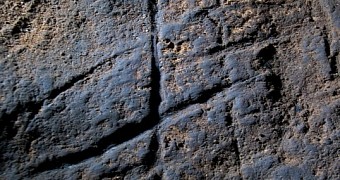Researchers led by Clive Finlanyson with the Gibraltar Museum say that, contrary to previous assumptions, Neanderthals did not just eat and sleep all day long. Recent evidence indicates that they used to make art, and that were pretty good at it.
In a paper published in this week's issue of the journal Proceedings of the National Academy of Sciences, the specialists document the discovery of several engravings in a chamber at the back of a cave in Gibraltar.
The engravings cover an area roughly the size of a Frisbee, and some of them are a few millimeters deep. It takes a trained eye to spot them. In fact, it was only while closely examining the chamber's walls that specialists noticed them.
“We started to shine the torch in different directions and we started to see the relief of this thing. It’s not immediately obvious,” researcher Clive Finlanyson with the Gibraltar Museum said in a statement, as cited by Nature.
These engravings, estimated to be well over 39,000 years old, are argued to have been made by Neanderthals. According to Clive Finlanyson and colleagues, they could very well be among the oldest art works thus far discovered in Europe.
Looking to prove that whoever made this alleged piece of artwork thousands of years ago wasn't just fooling around, researchers used original Neanderthal stone tools to create similar engravings. They found that, to create similar patterns, they had to repeatedly strike the rock in well-thought movements.
“We wanted to show that this was not a doodle, a casual thing, unlike the helter-skelter scratchings that the authors left when they sliced fresh pork skin on rock, for instance,” Clive Finlanyson explained the need to carry out this little experiment.
The supposed ancient masterpiece, a photo of which is available next to this article, was found inside Gorham's Cave. Archaeologists have been exploring this cave since the 1980s, and have found clear evidence that it used to be inhabited by Neanderthals.
Thus, archaeological evidence indicates that Neanderthals who lived in this part of the world thousands of years ago relied on Gorham's cave as a shelter, complete with a canteen. Hence the fact that fish, shellfish, and bird remains have been found inside it.
Although evidence indicates that the engravings constitute cave art made by Neanderthals over 39,000 years ago, Clive Finlanyson and fellow researchers admit that it is also possible that they are some bizarre map. “Is it art? I don’t know. I can’t get into the minds of these people,” the Gibraltar Museum specialist said.
“It looks geometric. It looks like criss-cross patterning. What is clear is that it’s abstract, it’s deliberate, and it speaks to their cognition in a way that brings Neanderthals, once again, closer to us,” Clive Finlanyson went on to explain.

 14 DAY TRIAL //
14 DAY TRIAL //